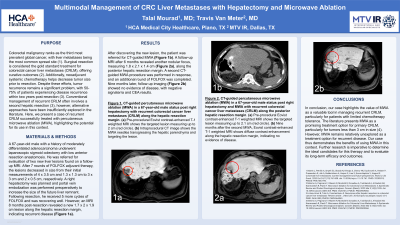Ablative Therapy
(17) Multimodal Management of CRC Liver Metastases with Hepatectomy and Microwave Ablation
Saturday, September 23, 2023
6:00 PM - 7:30 PM East Coast USA Time

Travis Van Meter, MD – Interventional Radiologist, MTVIR
Purpose: Colorectal malignancy ranks as the third most prevalent global cancer, with liver metastases being the most common spread site. Surgery is considered the gold standard treatment for colorectal cancer liver metastases (CRLM), offering curative outcomes. Neoadjuvant chemotherapy decreases tumor size prior to resection. Despite these efforts, recurrence remains a significant problem, with 50-75% of patients experiencing disease recurrence within two years post-resection. Conventional management of recurrent CRLM often involves a second hepatic resection, however, alternative approaches have been insufficiently explored in the literature. Here, we present a case of recurrent CRLM successfully treated with percutaneous microwave ablation (MWA), highlighting the potential for its use in this context.
Material and Methods: A 67-yo male with a history of moderately differentiated adenocarcinoma underwent laparoscopic sigmoid colectomy with LAR anastomosis. He was referred for evaluation of two new liver lesions found on a follow-up MRI. After 7 rounds of FOLFOX adjuvant therapy, the lesions decreased in size from their initial measurements of 4 cm and 1.3 cm to 3 cm and 0.5 cm, respectively. A right hepatectomy was planned and PVE was performed preoperatively to increase the size of the FLR. Following resection, he received 5 more cycles of FOLFOX and recovered well. However, an MRI 8 months post-resection revealed a new 2 cm lesion along the hepatic resection margin, indicating recurrent disease.
Results: After discovering the new lesion, the patient was referred for CT-guided MWA. A follow-up MRI after 6 months revealed another nodular focus, measuring 2.1 cm, along the posterior hepatic resection margin. A second CT-guided MWA procedure was performed and additional rounds of FOLFOX were completed. Nine months later, follow-up imaging showed no evidence of disease, with negative Signatera and CEA results.
Conclusions: In conclusion, our case highlights the value of MWA as a valuable tool in managing recurrent CRLM, particularly for patients with limited chemotherapy tolerance. Although the literature presents MWA as a feasible treatment option for primary CRLM, It remains relatively unexplored as a treatment option for recurrent disease. Therefore, further research is imperative to determine the ideal candidates for this therapy and to evaluate its long-term efficacy and outcomes.
Material and Methods: A 67-yo male with a history of moderately differentiated adenocarcinoma underwent laparoscopic sigmoid colectomy with LAR anastomosis. He was referred for evaluation of two new liver lesions found on a follow-up MRI. After 7 rounds of FOLFOX adjuvant therapy, the lesions decreased in size from their initial measurements of 4 cm and 1.3 cm to 3 cm and 0.5 cm, respectively. A right hepatectomy was planned and PVE was performed preoperatively to increase the size of the FLR. Following resection, he received 5 more cycles of FOLFOX and recovered well. However, an MRI 8 months post-resection revealed a new 2 cm lesion along the hepatic resection margin, indicating recurrent disease.
Results: After discovering the new lesion, the patient was referred for CT-guided MWA. A follow-up MRI after 6 months revealed another nodular focus, measuring 2.1 cm, along the posterior hepatic resection margin. A second CT-guided MWA procedure was performed and additional rounds of FOLFOX were completed. Nine months later, follow-up imaging showed no evidence of disease, with negative Signatera and CEA results.
Conclusions: In conclusion, our case highlights the value of MWA as a valuable tool in managing recurrent CRLM, particularly for patients with limited chemotherapy tolerance. Although the literature presents MWA as a feasible treatment option for primary CRLM, It remains relatively unexplored as a treatment option for recurrent disease. Therefore, further research is imperative to determine the ideal candidates for this therapy and to evaluate its long-term efficacy and outcomes.
